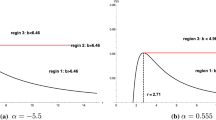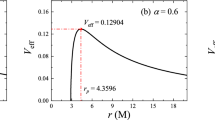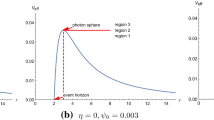Abstract
We study the optical appearance of a de Sitter–Schwarzschild black hole and its distinguishability from a Schwarzschild black hole. By exploring various accretion models and emission profiles, we investigate the impact of different parameters on the observed shadows and intensity profiles. Our analysis reveals that the outer edge of the shadow, corresponding to the apparent radius of the photon sphere, remains consistent regardless of the spherical accretion details or the size of the black hole. However, subtle differences in the overall brightness and intensity distribution can arise between these two black holes, especially for emission models with sharp peaks near the event horizon. We find that the de Sitter–Schwarzschild black hole tends to exhibit a slightly darker appearance in certain scenarios, while in others, it can appear slightly brighter than the Schwarzschild black hole. These distinctions become more prominent as the radial emission decreases more rapidly. Nevertheless, the size of the shadow alone is not sufficient to differentiate the potential differences in the optical appearance between the de Sitter–Schwarzschild black hole and the Schwarzschild black hole. Instead, distinctions may be observed in the overall brightness of the image.











Similar content being viewed by others

Data Availability
No Data associated in the manuscript.
Notes
A specific rest-frame frequency \(\nu _\star \) can be uniquely associated with a particular value of E.
References
K. Schwarzschild, Über das gravitationsfeld eines massenpunktes nach der einsteinschen theorie. Sitzungsberichte der Deutschen Akademie der Wissenschaften zu Berlin, Klasse für Mathematik, Physik, und Technik 1916, 189–196 (1916)
C.W. Misner, K.S. Thorne, J.A. Wheeler, Gravitation (Princeton Univ. Press, Princeton, USA, 2017)
R. M. Wald, General Relativity (Chicago Univ. Press, Chicago, USA, 1984) https://doi.org/10.7208/chicago/9780226870373.001.0001
S. W. Hawking and G. F. R. Ellis, The Large Scale Structure of Space-time, Cambridge Monographs on Mathematical Physics (Cambridge Univ. Press, Cambridge, UK, 2011) https://doi.org/10.1017/CBO9780511524646
J. M. Bardeen, Non-singular general-relativistic gravitational collapse, in Proc. Int. Conf. GR5, Tbilisi, Vol. 174 (sn, 1968) p. 174
I. Dymnikova, Vacuum nonsingular black hole. Gen. Rel. Grav. 24, 235 (1992). https://doi.org/10.1007/BF00760226
I. Dymnikova, De Sitter-Schwarzschild black hole: Its particle-like core and thermodynamical properties. Int. J. Mod. Phys. D 5, 529 (1996)
A. Borde, Regular black holes and topology change. Phys. Rev. D 55, 7615 (1997). https://doi.org/10.1103/PhysRevD.55.7615. arXiv:gr-qc/9612057
E. Ayon-Beato, A. Garcia, Regular black hole in general relativity coupled to nonlinear electrodynamics. Phys. Rev. Lett. 80, 5056 (1998). https://doi.org/10.1103/PhysRevLett.80.5056. arXiv:gr-qc/9911046
E. Ayon-Beato, A. Garcia, New regular black hole solution from nonlinear electrodynamics. Phys. Lett. B 464, 25 (1999). https://doi.org/10.1016/S0370-2693(99)01038-2. arXiv:hep-th/9911174
K.A. Bronnikov, J.C. Fabris, Regular phantom black holes. Phys. Rev. Lett. 96, 251101 (2006). https://doi.org/10.1103/PhysRevLett.96.251101. arXiv:gr-qc/0511109
S.A. Hayward, Formation and evaporation of regular black holes. Phys. Rev. Lett. 96, 031103 (2006). https://doi.org/10.1103/PhysRevLett.96.031103. arXiv:gr-qc/0506126
F.R. Klinkhamer, A new type of nonsingular black-hole solution in general relativity. Mod. Phys. Lett. A 29, 1430018 (2014). https://doi.org/10.1142/S0217732314300183. arXiv:1309.7011
V.P. Frolov, Notes on nonsingular models of black holes. Phys. Rev. D 94, 104056 (2016). https://doi.org/10.1103/PhysRevD.94.104056. arXiv:1609.01758 [gr-qc]
R. Carballo-Rubio, F. Di Filippo, S. Liberati, C. Pacilio, M. Visser, On the viability of regular black holes. JHEP 07, 023 (2018). https://doi.org/10.1007/JHEP07(2018)023. arXiv:1805.02675 [gr-qc]
Z.-L. Wang, Geodesic congruences in modified Schwarzschild black holes. Eur. Phys. J. C 82, 901 (2022). https://doi.org/10.1140/epjc/s10052-022-10843-7
K. Akiyama et al., (Event Horizon Telescope), First M87 Event horizon telescope results. I. The shadow of the supermassive black hole. Astrophys. J. Lett. 875, L1 (2019). https://doi.org/10.3847/2041-8213/ab0ec7. arXiv:1906.11238 [astro-ph.GA]
K. Akiyama et al., (Event Horizon Telescope), First M87 Event horizon telescope results. II. Array and instrumentation. Astrophys. J. Lett. 875, L2 (2019). https://doi.org/10.3847/2041-8213/ab0c96. arXiv:1906.11239 [astro-ph.IM]
K. Akiyama et al., (Event Horizon Telescope), First M87 Event horizon telescope results. III. Data processing and calibration. Astrophys. J. Lett. 875, L3 (2019). https://doi.org/10.3847/2041-8213/ab0c57. arXiv:1906.11240 [astro-ph.GA]
K. Akiyama et al., (Event Horizon Telescope), First M87 Event horizon telescope results. IV. Imaging the central supermassive black hole. Astrophys. J. Lett. 875, L4 (2019). https://doi.org/10.3847/2041-8213/ab0e85. arXiv:1906.11241 [astro-ph.GA]
K. Akiyama et al., (Event Horizon Telescope), First M87 Event horizon telescope results. V. Physical origin of the asymmetric ring. Astrophys. J. Lett. 875, L5 (2019). https://doi.org/10.3847/2041-8213/ab0f43. arXiv:1906.11242 [astro-ph.GA]
K. Akiyama et al., (Event Horizon Telescope), First M87 Event horizon telescope results. VI. The shadow and mass of the central black hole. Astrophys. J. Lett. 875, L6 (2019). https://doi.org/10.3847/2041-8213/ab1141. arXiv:1906.11243 [astro-ph.GA]
J.P. Luminet, Image of a spherical black hole with thin accretion disk. Astron. Astrophys. 75, 228 (1979)
H. Falcke, F. Melia, E. Agol, Viewing the shadow of the black hole at the galactic center. Astrophys. J. Lett. 528, L13 (2000). https://doi.org/10.1086/312423. arXiv:astro-ph/9912263
A. Övgün, I. Sakallı, J. Saavedra, Shadow cast and Deflection angle of Kerr-Newman-Kasuya spacetime. JCAP 10, 041 (2018). https://doi.org/10.1088/1475-7516/2018/10/041. arXiv:1807.00388 [gr-qc]
S.E. Gralla, D.E. Holz, R.M. Wald, Black hole shadows, photon rings, and lensing rings. Phys. Rev. D 100, 024018 (2019). https://doi.org/10.1103/PhysRevD.100.024018. arXiv:1906.00873 [astro-ph.HE]
R. Narayan, M.D. Johnson, C.F. Gammie, The shadow of a spherically accreting black hole. Astrophys. J. Lett. 885, L33 (2019). https://doi.org/10.3847/2041-8213/ab518c. arXiv:1910.02957 [astro-ph.HE]
M. Khodadi, A. Allahyari, S. Vagnozzi, D.F. Mota, Black holes with scalar hair in light of the Event Horizon Telescope. JCAP 09, 026 (2020). https://doi.org/10.1088/1475-7516/2020/09/026. arXiv:2005.05992 [gr-qc]
X.-X. Zeng, H.-Q. Zhang, H. Zhang, Shadows and photon spheres with spherical accretions in the four-dimensional Gauss-Bonnet black hole. Eur. Phys. J. C 80, 872 (2020). https://doi.org/10.1140/epjc/s10052-020-08449-y. arXiv:2004.12074 [gr-qc]
J. Peng, M. Guo, X.-H. Feng, Influence of quantum correction on black hole shadows, photon rings, and lensing rings. Chin. Phys. C 45, 085103 (2021). https://doi.org/10.1088/1674-1137/ac06bb. arXiv:2008.00657 [gr-qc]
M. Okyay, A. Övgün, Nonlinear electrodynamics effects on the black hole shadow, deflection angle, quasinormal modes and greybody factors. JCAP 01, 01 (2022). https://doi.org/10.1088/1475-7516/2022/01/009009. arXiv:2108.07766 [gr-qc]
Q. Gan, P. Wang, H. Wu, H. Yang, Photon ring and observational appearance of a hairy black hole. Phys. Rev. D 104, 044049 (2021). https://doi.org/10.1103/PhysRevD.104.044049. arXiv:2105.11770 [gr-qc]
V. Perlick, O.Y. Tsupko, Calculating black hole shadows: review of analytical studies. Phys. Rept. 947, 1 (2022). https://doi.org/10.1016/j.physrep.2021.10.004. arXiv:2105.07101 [gr-qc]
H.-M. Wang, Z.-C. Lin, S.-W. Wei, Optical appearance of Einstein-Æther black hole surrounded by thin disk. Nucl. Phys. B 985, 116026 (2022). https://doi.org/10.1016/j.nuclphysb.2022.116026. arXiv:2205.13174 [gr-qc]
W.-D. Guo, S.-W. Wei, Y.-X. Liu, Shadow of a charged black hole with scalar hair. Eur. Phys. J. C 83, 197 (2023). https://doi.org/10.1140/epjc/s10052-023-11316-1. arXiv:2203.13477 [gr-qc]
S. Vagnozzi et al., Horizon-scale tests of gravity theories and fundamental physics from the Event Horizon Telescope image of Sagittarius A. Class. Quant. Grav. 40, 165007 (2023). https://doi.org/10.1088/1361-6382/acd97b. arXiv:2205.07787 [gr-qc]
R.C. Pantig, A. Övgün, Testing dynamical torsion effects on the charged black hole’s shadow, deflection angle and greybody with M87* and Sgr. A* from EHT. Annals Phys. 448, 169197 (2023). https://doi.org/10.1016/j.aop.2022.169197. arXiv:2206.02161 [gr-qc]
R.C. Pantig, L. Mastrototaro, G. Lambiase, A. Övgün, Shadow, lensing, quasinormal modes, greybody bounds and neutrino propagation by dyonic ModMax black holes. Eur. Phys. J. C 82, 1155 (2022). https://doi.org/10.1140/epjc/s10052-022-11125-y. arXiv:2208.06664 [gr-qc]
A. Uniyal, R.C. Pantig, A. Övgün, Probing a non-linear electrodynamics black hole with thin accretion disk, shadow, and deflection angle with M87* and Sgr A* from EHT. Phys. Dark Univ. 40, 101178 (2023). https://doi.org/10.1016/j.dark.2023.101178. arXiv:2205.11072 [gr-qc]
X.-J. Wang, X.-M. Kuang, Y. Meng, B. Wang, J.-P. Wu, Rings and images of Horndeski hairy black hole illuminated by various thin accretions. Phys. Rev. D 107, 124052 (2023). https://doi.org/10.1103/PhysRevD.107.124052. arXiv:2304.10015 [gr-qc]
X.-J. Gao, X.-K. Yan, Y.-H. Yin, Y.-P. Hu, Gravitational lensing by a charged spherically symmetric black hole immersed in thin dark matter. Eur. Phys. J. C 83, 281 (2023). https://doi.org/10.1140/epjc/s10052-023-11414-0. arXiv:2303.00190 [gr-qc]
K. Nozari, S. Saghafi, Asymptotically locally flat and AdS higher-dimensional black holes of Einstein–Horndeski–Maxwell gravity in the light of EHT observations: shadow behavior and deflection angle. Eur. Phys. J. C 83, 588 (2023). https://doi.org/10.1140/epjc/s10052-023-11755-w. arXiv:2305.17237 [gr-qc]
A. Uniyal, S. Chakrabarti, M. Fathi, and A. Övgün, Observational Signatures: Shadow cast by the effective metric of photons for black holes with rational non-linear electrodynamics, (2023b), arXiv:2309.13680 [gr-qc]
M. Heydari-Fard, Effect of quintessence dark energy on the shadow of Hayward black holes with spherical accretion, (2022), arXiv:2209.09103 [gr-qc]
V. Cardoso, P. Pani, Testing the nature of dark compact objects: a status report. Living Rev. Rel. 22, 4 (2019). https://doi.org/10.1007/s41114-019-0020-4. arXiv:1904.05363 [gr-qc]
J.A.L. Rosa, C.F.B. Macedo, D. Rubiera-Garcia, Imaging compact boson stars with hot spots and thin accretion disks. Phys. Rev. D 108, 044021 (2023). https://doi.org/10.1103/PhysRevD.108.044021. arXiv:2303.17296 [gr-qc]
J.A.L. Rosa, Observational properties of relativistic fluid spheres with thin accretion disks. Phys. Rev. D 107, 084048 (2023). https://doi.org/10.1103/PhysRevD.107.084048. arXiv:2302.11915 [gr-qc]
C. Bambi, Can the supermassive objects at the centers of galaxies be traversable wormholes? The first test of strong gravity for mm/sub-mm very long baseline interferometry facilities. Phys. Rev. D 87, 107501 (2013). https://doi.org/10.1103/PhysRevD.87.107501. arXiv:1304.5691 [gr-qc]
T. Ohgami, N. Sakai, Wormhole shadows. Phys. Rev. D 91, 124020 (2015). https://doi.org/10.1103/PhysRevD.91.124020. arXiv:1704.07065 [gr-qc]
X. Wang, P.-C. Li, C.-Y. Zhang, M. Guo, Novel shadows from the asymmetric thin-shell wormhole. Phys. Lett. B 811, 135930 (2020). https://doi.org/10.1016/j.physletb.2020.135930. arXiv:2007.03327 [gr-qc]
H. Huang, J. Kunz, J. Yang, C. Zhang, Light ring behind wormhole throat: geodesics, images, and shadows. Phys. Rev. D 107, 104060 (2023). https://doi.org/10.1103/PhysRevD.107.104060. arXiv:2303.11885 [gr-qc]
Z.-L. Wang, On a Schwarzschild-type defect wormhole, arXiv:2307.01678 [gr-qc]
R. Shaikh, P. Kocherlakota, R. Narayan, P.S. Joshi, Shadows of spherically symmetric black holes and naked singularities. Mon. Not. Roy. Astron. Soc. 482, 52 (2019). https://doi.org/10.1093/mnras/sty2624. arXiv:1802.08060 [astro-ph.HE]
R. Shaikh, P.S. Joshi, Can we distinguish black holes from naked singularities by the images of their accretion disks? JCAP 10, 064 (2019). https://doi.org/10.1088/1475-7516/2019/10/064. arXiv:1909.10322 [gr-qc]
D. Dey, R. Shaikh, P.S. Joshi, Shadow of nulllike and timelike naked singularities without photon spheres. Phys. Rev. D 103, 024015 (2021). https://doi.org/10.1103/PhysRevD.103.024015. arXiv:2009.07487 [gr-qc]
G. Gyulchev, J. Kunz, P. Nedkova, T. Vetsov, S. Yazadjiev, Observational signatures of strongly naked singularities: image of the thin accretion disk. Eur. Phys. J. C 80, 1017 (2020). https://doi.org/10.1140/epjc/s10052-020-08575-7. arXiv:2003.06943 [gr-qc]
D. Mihalas, B. Weibel Mihalas, Foundations of radiation hydrodynamics (Oxford University Press, New York, 1984)
X.-X. Zeng, H.-Q. Zhang, Influence of quintessence dark energy on the shadow of black hole. Eur. Phys. J. C 80, 1058 (2020). https://doi.org/10.1140/epjc/s10052-020-08656-7. arXiv:2007.06333 [gr-qc]
A.M. Bauer, A. Cárdenas-Avendaño, C.F. Gammie, N. Yunes, Spherical accretion in alternative theories of gravity. Astrophys. J. 925, 119 (2022). https://doi.org/10.3847/1538-4357/ac3a03. arXiv:2111.02178 [gr-qc]
P. Kocherlakota, L. Rezzolla, Distinguishing gravitational and emission physics in black hole imaging: spherical symmetry. Mon. Not. Roy. Astron. Soc. 513, 1229 (2022). https://doi.org/10.1093/mnras/stac891. arXiv:2201.05641 [gr-qc]
F. Yuan, R. Narayan, Hot accretion flows around black holes. Ann. Rev. Astron. Astrophys. 52, 529 (2014). https://doi.org/10.1146/annurev-astro-082812-141003. arXiv:1401.0586 [astro-ph.HE]
I. Dymnikova, Spherically symmetric space-time with the regular de Sitter center. Int. J. Mod. Phys. D 12, 1015 (2003). https://doi.org/10.1142/S021827180300358X. arXiv:gr-qc/0304110
Acknowledgements
It is a pleasure to thank Xiao-Yan Chew and Yong-Zhuang Li for useful discussions. This work is supported by the Natural Science Research Project of Colleges and Universities in Jiangsu Province (21KJB140001) and Natural Science Foundation of Jiangsu Province (BK20220642).
Author information
Authors and Affiliations
Corresponding author
Appendices
Appendix 1: Review of the de Sitter–Schwarzschild spacetime
The de Sitter–Schwarzschild spacetime was considered to be a solution of Einstein field equations with the following density profile [6]
One could define the mass function as
with which the metric (1) could be written as
Depending on the ratio of \(r_g/r_0\), the metric (1) can describe either a black hole or a gravitational object without an event horizon. In the case where there is no event horizon, the object is referred to as a G-lump, a term coined by Dymnikova [62]. For a given \(r_0\), the critical value of \(r_{g.\textrm{cr}}\) could be found by solving the following equations
where the prime denotes the derivative with respect to r and where \(r_{\textrm{cr}}\) is location of the horizon. Equation (A4) reduce to
The numerical physical solution for this equation yields \(r_{\textrm{cr}}\approx 1.49571 r_0\) and \(r_{g.\textrm{cr}}\approx 1.75759 r_0\). For \(r_g>r_{g.\textrm{cr}}\), the metric (1) describes a black hole with two event horizons and these two horizons degenerate at \(r_g=r_{g.\textrm{cr}}\). For \(r_g<r_{g.\textrm{cr}}\), the metric describes the G-lump. Examples of different de Sitter–Schwarzschild metric are shown in Fig. 12.
Appendix 2: Geodesics of de Sitter–Schwarzschild black hole
For a static spherically symmetric metric which has the form:
the static Killing vector field \((\partial /\partial t)^{\mu }\) and the rotational Killing vector field \((\partial /\partial \phi )^{\mu }\) yield the following constants of the motion for geodesics, respectively:
where \(\lambda \) being the proper time for massive particle or the affine parameter for massless particle. Without loss of generality, we shall restrict our attention to the equatorial geodesics, i.e., \(\theta =\pi /2\).
With the help of Eq. (B2), the geodesic equations
can be simplified to
with constant \(N=0\) for a massless particle and \(N=1\) for a massive particle.
Note that Eq. (B4b) has the same form of the equation for a particle with unit effective mass and energy \(E^2/2\) moving in a one-dimensional effective potential
Combining Eqs. (B4b) and (B4c), we obtain
Left panel: Effective potential for massive particles with angular momentum \(J=\sqrt{12}M\) in de Sitter–Schwarzschild spacetime, considering various values of \(r_g/r_0\). For comparison purposes, we also include the corresponding results for the Schwarzschild spacetime, represented by dashed line. All these effective potentials have a local minimal at \(r\approxeq 6M\), which corresponds to a stable circular orbits. Right panel: Effective potential for massive particles with different values of angular momentum J in a de-SBH with \(r_g/r_0=1.76\)
For null geodesics (\(N=0\)), the effective potential is given by
For a de-SBH, we have
The equation for the effective potential and \({\textrm{d}r}/{\textrm{d}\phi }\) are given by
which are Eqs. (5) and (7), respectively. Figure 13 show the effective potential for massless particles in de Sitter–Schwarzschild spacetime.
For timelike geodesics, \(N=1\), and the effective potential of a de-SBH is given by
Examples of the effective potential are plotted in Fig. 14. The location of the stable circular orbits can be denoted by \(r_{\textrm{SCO}}\) (\(r_{\textrm{SCO}}>r_{h}\)), which corresponds to the local minimal of the effective potential outside the event horizon. Note that \(r_{\textrm{SCO}}\) is J dependent, and the minimal \(r_{\textrm{SCO}}\) gives the location of the innermost stable circular orbits \(r_{\textrm{ISCO}}\). The innermost stable circular orbits for de-SBHs is nearly equal to that of the SBH, i.e., \(r_{\textrm{ISCO}}\approxeq 6\,M\).
Rights and permissions
Springer Nature or its licensor (e.g. a society or other partner) holds exclusive rights to this article under a publishing agreement with the author(s) or other rightsholder(s); author self-archiving of the accepted manuscript version of this article is solely governed by the terms of such publishing agreement and applicable law.
About this article
Cite this article
Wang, ZL. Shadows and rings of a de Sitter–Schwarzschild black hole. Eur. Phys. J. Plus 138, 1131 (2023). https://doi.org/10.1140/epjp/s13360-023-04756-x
Received:
Accepted:
Published:
DOI: https://doi.org/10.1140/epjp/s13360-023-04756-x






